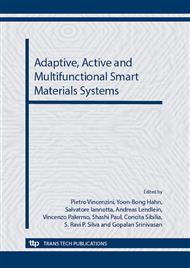[1]
F.A. Müller, M.C. Bottino, L. Müller, V.A.R. Henriques, U. Lohbauer, A.H.A. Bressiani, J.C. Bressiani, In vitro apatite formation on chemically treated (P/M) Ti–13Nb–13Zr. Dent. Mat. 24 (2008) 50-56.
DOI: 10.1016/j.dental.2007.02.005
Google Scholar
[2]
G.He, M. Hagiwara, Bimodal structured Ti-base alloy with large elasticity and low Young's modulus. Mat. Sci. Eng. C. 25 (2005) 290-295.
DOI: 10.1016/j.msec.2005.03.001
Google Scholar
[3]
M. Geetha, A.K. Singh, A.K. Gogia, R. Asokamani, Effect of thermomechanical processing on evolution of various phases in Ti–Nb–Zr alloys. J. Alloys Compd. 384 (2004) 131-144.
DOI: 10.1016/j.jallcom.2004.04.113
Google Scholar
[4]
Y. cui, Y. Li, K. Luo, H. Xu, Microstructure and shape memory effect of Ti–20Zr–10Nb alloy. Mat. Sci. Eng. A. 527 (2010) 652-656.
DOI: 10.1016/j.msea.2009.08.063
Google Scholar
[5]
V.A.R. Henriques, H.R.Z. Sandim, G.C. Coelho, C.R.M. da Silva, Microstructural evolution during hot pressing of the blended elemental Ti-6%l-7%Nb alloy. Mat. Sci. Eng. A. 347 (2005) 315-324.
DOI: 10.1016/s0921-5093(02)00604-4
Google Scholar
[6]
C.R.M. Afonso, G.T. Aleixo, A.J. Ramirez, R. Caram, Influence of cooling rate on microstructure of Ti–Nb alloy for orthopedic implants. Mat. Sci. Eng. C. 2 (2007) 908-913.
DOI: 10.1016/j.msec.2006.11.001
Google Scholar
[7]
S.B. Gabriel, G.Silva, K.C.G. Candioto, I.D. Santos, P.A. Suzuki, C.A. Nunes, Niobium hydrogenation process: Effect of temperature and cooling rate from the hydrogenation temperature. Int. J. Refract. Met. Hard. Mater. 29 (2011) 134-137.
DOI: 10.1016/j.ijrmhm.2010.09.006
Google Scholar
[8]
K.C.G. Candioto, C.A. Nunes, Nb–20%Ta alloy powder by the hydriding–dehydriding technique. Int. J. Refract. Met. Hard. Mater. 24 (2006) 413-417.
DOI: 10.1016/j.ijrmhm.2005.06.001
Google Scholar
[9]
C. Suryanarayana, Mechanical alloying and milling. Prog. Mater. Sci. 46 (2001) 1-184.
Google Scholar
[10]
A. Nouri, P.D. Hodgson, C.E. Wen, Effect of process control agent on the porous structure and mechanical properties of a biomedical Ti–Sn–Nb alloy produced by powder metallurgy. Acta Biomater. 6 (2010) 1630-1639.
DOI: 10.1016/j.actbio.2009.10.005
Google Scholar
[11]
T. Ahmed, H.J. Rack, Martensitic transformations in Ti-(16-26 at %) Nb Alloys, J. Mat. Science. 31 (1996) 4267-4276.
DOI: 10.1007/bf00356449
Google Scholar
[12]
N.B.D. Yakonova, I.V. Lyasotskii, Y.V. Rodionov, Orthorhombic Martensite and the w Phase in Quenched and Deformed Titanium Alloys with 20–24 at % Nb. Rus. Metallurgy. 1 (2007) 51-58.
DOI: 10.1134/s0036029507010107
Google Scholar
[13]
M. Niinomi, Mechanical properties of biomedical titanium alloys. Mat. Sci. Eng. A. 243 (1998) 231-236.
Google Scholar
[14]
X. Liu, P.K. Chu, C. Ding, Surface modification of titanium, titanium alloys, and related materials for biomedical applications. Mat. Sci. Eng. R. 47 (2004) 49-121.
DOI: 10.1016/j.mser.2004.11.001
Google Scholar
[15]
S.B. Gabriel, J. Dille, C.A. Nunes, G.A. Soares, The Effect of Niobium Content on the Hardness and Elastic Modulus of Heat-Treated Ti-10Mo-XNb Alloys. Mat. Res. 13 (2010) 333-337.
DOI: 10.1590/s1516-14392010000300009
Google Scholar


